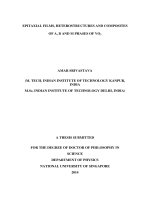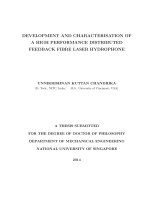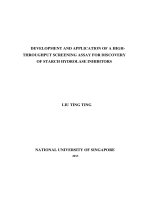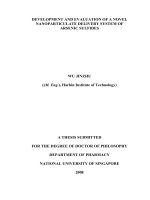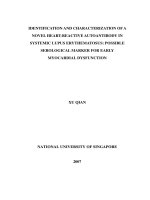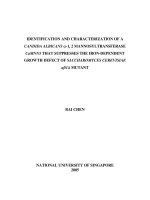Qualitative (Flow Pattern) and QuantitativeComputation of the Filling Process of a Mold(Simulation Models)
Bạn đang xem bản rút gọn của tài liệu. Xem và tải ngay bản đầy đủ của tài liệu tại đây (1.63 MB, 40 trang )
Previous Page
quality problems for injection-molded parts because, on the one hand, a high filling
pressure causes pronounced orientation in the molded part that in this form - and
especially with filled materials - is often undesirable and troublesome. On the other
hand, the maximum attainable flow-path lengths and the minimum part wall thickness
are restricted by this. The gates and runners for molds that are intended for processing
highly-filled polymers should therefore, also for these thermodynamic reasons, have a
larger cross-section than is usual for thermoplastic molds.
An alternative to large-dimensioned gates, that also serves to counteract freezing
effects, is hot-runner systems. These permit much longer, more selective influence to be
exerted on the molded-part-formation process in the holding-pressure phase [5.21].
Since the formation of a frozen edge layer in the runner is suppressed, pressure losses
are reduced. The disadvantage of this is the need for elaborate, thermal insulation of the
hot-runner system toward the cavity with the risk of high orientation near the gate, where
the material remains molten for a long time. This problem has been successfully
eliminated in powder injection molding by using combinations of hot runners with short,
freezing gates [5.22, 5.23]. The effect is that the areas of high orientation are pushed into
the gate area to be later removed and therefore do not have any effect on the quality of
the molded part.
5.9
Qualitative (Flow Pattern) and
Quantitative
C o m p u t a t i o n of t h e Filling P r o c e s s of a M o l d
( S i m u l a t i o n M o d e l s ) [5.24]
5.9.1
Introduction
It is often necessary to study the filling process of a finished mold in advance, that is
during the conception of mold and molding. Examinations of this kind are generally
summarized under the generic expression "rheological design" [5.25, 5.28] and make a
qualitative and quantitative analysis of the later flow process possible. Qualitative
analysis here is the composition of a flow pattern, which provides information
concerning
-
effective kind and position of gates,
ease of filling individual sections,
location of weld lines,
location of likely air traps and
directions of principal orientation.
Aids for theoretically composing a flow-pattern are the flow-pattern method [5.27 to
5.29] and calculation software for computers capable of graphics [5.29, 5.30].
The second step is the quantitative analysis. This is a series of calculations, which
include the behavior of the material and assumed processing parameters. They determine
mold filling data such as
-
pressures,
temperatures,
shear rate,
shear stresses, etc.
With the help of these calculations the effect of planned design features can be estimated,
e-g.
- properties of the molded part,
- strength of weld lines,
- surface quality,
- damage to material,
- selection of material and machine,
- suitable range of processing, etc.
5.9.2
T h e Flow P a t t e r n a n d its Significance
A flow pattern pictures the courses of the flow fronts in different areas of the cavity at
various stages of the mold-filling process. The theoretical filling image corresponds with
the production of short shots in a finished mold. Figures 5.35 to 5.37 demonstrate a
comparison between a theoretical flow pattern and a series of short shots from a practical
test.
Producing a flow pattern during part or mold design is beneficial because it makes it
possible to recognize the location of weld lines and air trappings early on, that is before
the mold is made.
If such problems are recognized, one can examine how the mold filling can be
improved by
- a variation of position, kind and number of gates,
- a variation of the location of holes or different thicknesses of sections, which are
demanded by design,
- introduction of facilities or restraints for the melt flow.
Trapped air
Change in wall
thickness
Before
Figure 5.35
After
Comparison of theoretical flow pattern and injection trial
Figure 5.36
Series of short shots illustrating filling of box mold [5.24]
Wall thickness
Knit line
Figure 5.37 Flow
pattern of a box-shaped
molding [5.24]
The production of a flow pattern is a pre-condition for the use of programs to compute
pressure and temperature during the filling stage. Accurate computation requires a
mental break down of the molded part or cavity into computable basic segments, which
are established on the basis of the flow pattern.
5.9.3
Using t h e Flow P a t t e r n for Preparing a Simulation
of t h e Filling Process
For producing a flow pattern one starts with a plane presentation of the part or its
development onto a plane.
In essence, three geometrical operations are necessary for such a development:
- cutting open a surface along an edge,
- turning a face around a fixed axis,
- stretching a curved surface (flatten it onto the plane of the paper).
The following considerations and simplifications result in developments, which favor
the later production of a flow pattern:
- If possible, the actual part should be divided into subsections, which can be developed
in a simple way (making the cut along an existing edge). The correlation in the
-
developed presentation is then done by identifying the common connecting lines
(cutting edges) or points (Figure 5.38).
That face is the starting surface, on which the gate(s) is (are) placed or on which the
longest flow paths can be expected.
Areas, which cannot be directly included in the development of connected part sections
(e.g. ribs), are folded separately onto the paper plane.
Connection points of areas (ribs), which are presented in subdevelopments, have to be
clearly identified (Figure 5.38).
Another way of developing complex parts begins with a paper model, which is subsequently cut open.
Conversely, a flow pattern can give a clear idea by cutting out the individual sections
and joining the parts.
Figure 5.38 Examples for development on a plane [5.24]
5.9.4
Theoretical Basis for Producing a Flow P a t t e r n
According to Hagen-Poiseuille the pressure demand to counter the resistance to flow in
plate-like channels (W > H) is [5.31]:
(5.1)
Wherein
Ap
Pressure consumption,
(p
Factor for real molds,
For molds with W » H -^ vF
Velocity of advancing flow front,
L
Length of flow path,
W
Width of segment,
H
Height of a segment,
q
Viscosity of fluid.
Since only the flow front is considered, it is permissible to assume that
a) all factors everywhere along the flow front are equal. This is the case as long as the
whole range has the shape of a plate with uniform thickness;
b) the pressure is uniform, which automatically follows for the flow front;
c) the viscosity along the flow front is the same. This is the case as long as the melt along
the flow front is of equal temperature and no larger differences in height exist, which
would change the intrinsic viscosity, that is H 1 / H 2 < 5.
Always equally wide segments of the flow front are considered, that is W 1 = W 2 . Thus,
for two points of the flow front with different thickness H follows
(5.2)
One introduces
and looks at the movement of the flow front in equal time steps so that
At = const.
then
(5.3)
and because
L 1 = AL1 and L 2 = AL 2
the result is
(5.4)
The advance of the flow front in equal time intervals corresponds with the ratio of
thicknesses at the points considered.
Present experience demonstrates a very good agreement between flow pattern and
practical results as long as one can assume that the flow front is uniformly supplied with
melt. This holds true in all cases even for very different materials from very fluid
reactive polyurethanes or caprolactams to elastomers and filled thermosets. If,
however, narrow cross-sections, such as a living hinge, restrict the filling, then a
deviation from the location of weld lines in the following area can be noticed. This,
however, has never really interfered with the qualitative prediction of the location of
weld lines. If this method, however, should serve to compute pressure and temperature
in a simulation program (CADMOULD or MOLDFLOW) then the result has a
considerable error in such cases.
5.9.5
Practical P r o c e d u r e for Graphically Producing
a Flow P a t t e r n
5.9.5.1
Drawing the Flow Fronts
The model on which the method of the flow pattern is based, relies on the theory of wave
propagation according to Huygens. It implies that every point of an "old" wave front
(flow front) can be considered the starting point (center) of a so-called elementary
wavelet (circular wave). The envelope of the new elementary wavelets is the new (next)
wave front (flow front). The "new" flow front is the envelope of the new elementary
wavelets, which expand in circular form from every point of the last flow front. The
radius of every elementary wavelet is equal to the advance of the flow front Al (Figures
5.39 and 5.40).
5.9.5.2 Radius Vectors for the Presentation of Shadow Regions
Areas of a part which are located in the "shadow" of openings cannot be directly reached
by parallel or swelling flow from the gate. They are filled beginning from a flow front
(Figure 5.41).
Vectors starting at the gate indicate these regions and offer points of support for
producing the flow front (Figure 5.42).
The points P, where the vectors are tangent to the opening, are, as points of an "old"
flow front, the origins of new elementary wavelets. They start the filling of the shadow
regions (Figure 5.43 to 5.45).
With complex shapes of openings or barriers to flow it may be necessary to introduce
more vectors during the process to completely cover the flow around them (Figure 5.46).
New flow front
Od
l flow front
Elementary wavelets
New flow front
New flow front
Elementary
wavelets
Od
l flow front
Od
l flow front
Sweling flow
Figure 5.39
Parallel flow
Methodology of designing a flow pattern [5.24]
Swelling flow
Parallel flow
Figure 5.40 Application with pinpoint gate
(left) and edge gate (right) [5.24]
Areas not directly accessible
Opening
Figure 5.41 Design of a flow front with
elementary wavelets behind an opening [5.24]
Edge gate
Pinpoint gate
Figure 5.42 Vectors outline areas which
are not directly accessible [5.24]
Figure 5.43 Design of a flow
front behind flow barriers [5.24]
right: Edge gate,
left: Pinpoint gate
Figure 5.44 Design of flow
front behind a rectangular
opening [5.24]
right: Edge gate,
left: Pinpoint gate
+ gate
weld line
Figure 5.45 Design of flow
front behind circular opening
[5.24]
right: Edge gate,
left: Pinpoint gate
Vector 1
Vector 2
Figure 5.46 Design of flow front with several vectors
[5.24] (pinpoint gate)
5.9.5.3 Areas with Differences in Thickness
A special benefit of the flow pattern method is the correct determination of the filling
process even if there are differences in thickness (height). For a one-time step there is
the relation
Al
— = const.
H
(5.5)
This means that the ratio of advancement of the flow front Al and its height H is the same
in different regions of the cavity during the same time intervals At.
This relation becomes evident with center-gated plates, one with constant thickness,
the other one with twice the thickness in one half (Figure 5.47).
The tangential design as an aid for producing a flow pattern is used if a continuous
flow front is drawn in adjacent areas with different section thickness. The flow from a
region with a thicker section into one with a thinner one is approximated by linear
interpolation between known points of the "new" front. This method is an approximation
of the central design, which will be discussed later.
Figure 5.47 Flow front with
varying wall thickness [5.24]
Various steps of this method:
1. The last flow front just touches the border of the region with a thicker section (II) at
the point P (Figure 5.48).
2. First the continuation Al1 in the old region is drawn. This results in the known points
A and B of the new front, at the border of the region II. Starting at the point P of the
old flow front the circle of an elementary wavelet is outlined in the region II. The
radius results from the rule Aln = Al1 Hn/Hj (Figure 5.49).
Area Il
Area 2
Figure 5.48 Tangential design,
step 1 [5.24]
Figure 5.49 Tangential design,
step 2 [5.24]
3. The tangents are drawn from the known point A and B of the "new" flow front to the
circle of the swelling flow (Figure 5.50).
4. This generates the complete sequel of the new front (Figure 5.51).
Figure 5.50 Tangential design, step
3 [5.24]
Figure 5.51 Tangential design,
step 4 [5.24]
5. If the region II is thinner than the region I, the flow from I to II is pictured as described
above. If the region II is thicker than region I the flow from I to II is considered by a
second circle for a wavelet with tangents to it (Figure 5.52).
Area Il
Step]
Figure 5.52
Area I
Step 2
Tangential design, H11 > H1 [5.24]
Step 3
The central design, another aid to produce a flow pattern, is a refinement of the
tangential design.
Instead of a linear interpolation between known points, an interpolation of a circular
arc is carried out. It should be primarily applied for
- large step sizes, or
- large differences in section thickness between adjacent regions.
Various steps of this method:
1. The last flow front just touches the border of a region with a different section thickness in the point P (Figure 5.53).
2. The new front is drawn with the advance Al1, in the old region. This results in known
points A and B of the new flow front in the region II. Starting with point P of the old
front the advance Aln is outlined in region II. It results from the rule Aln = Al1 • HnZH1.
Thus another point C of the new flow front has been determined (Figure 5.54).
3. There are now three points of the new flow front A, B and C. The points A and C as
well as B and C are connected by a straight line and their median verticals erected.
Their intersection is the center M (Figure 5.55).
4. A circular arc through the points A, B and C represents the new flow front in the
region II (Figure 5.56).
As a comparison the flow front according to the tangential design for the same example
is shown (Figure 5.57).
Some more examples for both methods are presented in Figures 5.58 to 5.60. A
combination of tangential and central design is also possible (Figure 5.61). The central
design pictures the flow into region I and II and the tangential design the overflow from
I to II (Figure 5.62).
Area Il
Area I
Figure 5.53
Central design, step 1 [5.24]
Figure 5.55 Central design, step 3 [5.24]
Figure 5.54
[5.24]
Central design, step 2
Figure 5.56 Central design, step 4
[5.24]
Figure 5.57 Flow front based on
tangential design [5.24]
Figure 5.58 Determination of flow
pattern with central design [5.24]
Area Il
Figure 5.59 Determination of flow
pattern with tangential design [5.24]
Area I
•Weld line
Direction of flow
Figure 5.60 Determination of flow
pattern with tangential design [5.24]
Figure 5.61
Determination of
flow pattern with
tangential and central
design [5.24]
Here, tangential and central design can also be combined (Figure 5.63). The first one
pictures the overflow from region II to I and the second one the flow into regions I and
II.
5.9.5.4
Flow Patterns of Ribs
First, ribs are looked at which are thinner than the base (Figure 5.64). They are filled
from the base and do not affect the flow pattern of the main body.
In Figure 5.64 venting should be provided in the corner C; the rib should not be
machined as a closed pocket.
Area Il
Area I
Weld line
Direction of flow
Figure 5.62 Determination of flow
pattern with tangential design [5.24]
Figure 5.63
Determination of flow
pattern with tangential
and central design [5.24]
Another example is shown with Figure 5.65. Here provisions should be made for venting
at the points A and B.
The filling of ribs which are thicker than the base is demonstrated with Figure 5.66.
The advancement of melt in a thick rib affects the flow pattern of the base area. Venting
should be provided in the corner C and at the ends of both weld lines.
5.9.5.5
Flow Pattern of Box-Shaped Moldings
In the development, connecting lines (cutting lines) of continuous regions are presented
as curves, in special cases as straight lines. For the determination of a filling image the
advances of the flow have to be picked off from one connecting line and transferred to
the proper "opposite" connecting line to correctly determine an advance of flow or an
overflow (Figure 5.67).
5.9.5.6 Analysis of Critical Areas
Knit lines are created by several merging melt flows. They occur, in any case, behind
openings.
In a flow pattern, points of a knit line are recognized as "breaks" in the course of the
flow front. Then the knit line results from a connecting line of these points.
Central
design
Tangential
design
Figure 5.64
Rib thinner than base [5.24]
Figure 5.65
[5.24]
Ribs thinner than base
Central design
Figure 5.66
[5.24]
Rib thicker than base
Tangential design
Figure 5.67
Junction in a box-shaped molding [5.24]
The smaller the angle of two merging flow fronts becomes, the more pronounced the knit
line (and the reduction in quality) is (Figure 5.68).
Weld lines close to the gate are less critical than those far from it because they are
created at relatively high temperatures and are possibly passed through by following
melt. Weld lines far from the gate may present weak points because of cool melt and poor
welding.
Air trapping occurs if flow fronts merge and the air cannot escape through a parting
line or any other way (Figure 5.69). Besides incomplete filling, burned spots may be the
consequence.
The faces at the parting lines should be carefully ground (grain size 240, but not
finer).
Figure 5.68 Weld lines [5.24]
left: Pronounced
right: Insignificant
Parting line
Figure 5.69 Air trapping
[5.24]
left: Crucial
right: Not crucial
If the air cannot escape through an existing parting line, the problem can be redressed
by:
-
use of an additional parting line,
relocation of ejector pins into areas of air trapping (air escapes through holes),
venting pins,
relocation of gate,
modification of section thickness of part (see Chapter 7).
5,9.5-7
Final Comments
The following recommendations should provide help with complicated applications.
They are based on frequent experience with flow patterns in practice.
- The design with elementary wavelets is well suited for the continuation of a flow front
in regions of equal section thickness. It is always applicable and should be employed
if difficulties arise with a different design.
- The central design is suggested if a region of different section thickness has to be
filled. It is more accurate than the tangential design but also more work.
- The tangential design should be used if an overflow from a heavier section into a
region with a thinner section perpendicular to the direction of flow takes place.
Although the central design can be employed here, too, it takes much more time, in
particular if for every flow front a new center has to be found.
- The maximum "step width" should be selected so long that a "problem point" is just
reached.
Problem points are
- reaching of a region of different thickness,
- filling of a "shadow area" (radius vector),
- overflow from a region with heavier into one with thinner section (perpendicular to the
direction of flow in the heavier section),
- merging of flow fronts (weld lines, air trapping).
5.9.6
Quantitative Analysis of Filling
A quantitative analysis is based on the concepts of fluid dynamics (rheology) and
thermodynamics. It has to solve the fundamental equations for continuity, momentum,
and energy. This is a matter of an interactive system of differential equations
(Figure 5.70). For such a complex geometry as the cavity of an injection mold, no exact
solution can be found, of course, so that some method of approximation has to be used.
There are two possibilities:
a) The geometry is subdivided by a set of a finite number of nodal points equally spaced
by small time intervals. Each point represents a finite difference approximation. With
the resulting set of difference equations a final solution can be found [5.26, 5.27].
b) The geometry is divided into subregions called finite elements. An approximation
with small time intervals is defined within each element according to known
procedures and appropriate continuity conditions imposed on the inter-element
boundaries (Figure 5.71) [5.9].
Disc
Generating flow
Plate
Cylinder
Established flow
Continuity equation
Impulse equation
Energy equation
Figure 5.70 Computation of the flow process (basic equations) [5.26, 5.27]
Both methods call for the application of computers, which will be treated in detail in
Chapter 14. They are suitable for other material melts or reactive liquids (RIM) as well.
5.9.7
Analytical Design of R u n n e r s a n d G a t e s
5.9,7,1
Rheological Principles [5.32]
A general flow is completely described by the conservation laws of mass, momentum
and energy and by a rheological and thermodynamic equation of state. The rheological
equation of state, also called the law of materials, describes the relation between the flow
rate field and the resultant stress field. This accounts for all the flow properties of the
polymer concerned. The describing, explaining and measuring of the flow properties of
materials is a key subject of the science of deformation and flow of matter, known as
rheology [5.33]. The principles of rheology will be introduced in this chapter in as far as
they are necessary for the design of gates and runners from an engineer's point of view.
Polymer melts do not exhibit purely viscous behavior, but possess a not inconsiderable
amount of elasticity. Their properties, therefore, lie between those of an ideal fluid and
an ideal (Hookean) solid. They are said to exhibit viscoelastic behavior or visco-
Disc
Plate
Generating flow
Cylinder
Established flow
Velocity profile
Mean velocity
Shear rate
Pressure gradient
implicit in
velocity profile
Figure 5.71 Computation of theflowprocess (definitive equations) [5.26, 5.27]
elasticity. It is therefore common to distinguish between material data pertaining to
purely viscous behavior and material data pertaining to elastic behavior when describing
rheology.
Viscous Melt Properties
In the flow processes of the kind that occur in injection molds, the melt is mainly
sheared. This so-called shear flow is due to adhesion of the polymer melts to the surfaces
of the mold halves shaping them (Stokes' adhesion). The result is a change in flow rate
across the channel cross-section that is described by the shear rate:
(5.6)
v
y
Flow rate,
Direction of shear.
Under stationary shear flow, shear stress T occurs between the fluid layers. In the
simplest case of a Newtonian fluid, the shear stress T is proportional to the shear rate 7,
yielding:
T = T] • 7
(5-7)
The proportionality factor is called the dynamic shear viscosity or simply viscosity.
It has the unit Pa s. The viscosity is a measure of the internal flow resistance of a
sheared fluid.
In general, polymer melts do not exhibit Newtonian behavior. Their viscosity is not
constant but instead depends on the shear rate. By analogy with the equation for
Newtonian fluids, Equation (5.7), the flow law is as follows:
T = T](7) • 7
(5-8)
T1(ZY) = T T^const.
(5.9)
and
Note:
The viscosity of many polymers exhibits a more or less pronounced time dependency
(thixotropy, rheopexy, lag in viscosity under sudden shear or strain [5.33-5.35]).
However, this time dependency is usually ignored when injection molds are being
designed because usually the appropriate data are not available. And yet, this supposition
can cause errors, albeit small ones, in calculations. The time dependency will be ignored
in the following discussion.
Viscisity log n
Viscosity and Flow Function
A double logarithmic plot of viscosity as a function of shear rate (at constant temperature) for polymers has the basic shape shown in Figure 5.72. It can be seen that the
viscosity remains constant at low shear rates but declines as the shear rate increases.
Behavior of the kind that the viscosity decreases with the shear rate is termed
structural viscosity or pseudoplasticity. The constant viscosity for low shear rates is
Figure 5.72 Viscosity as a
function of shear rate in the
Shear rate log •%form of a viscosity curve
Shear rate log ^
Non-Newtonian fluid
Newtonian fluid
Figure 5.73 Shear rate as a function of shear
stress in the form of a flow curve
Shear stress log x
called the Newtonian viscosity, lower Newtonian intrinsic viscosity or when 7 = 0 as
zero viscosity 0.
Not only can the viscosity be plotted as a function of the shear rate to yield a viscosity
curve, but the shear stress can be plotted against the shear rate (also on a double
logarithmic scale) to yield a flow curve (Figure 5.73).
In a Newtonian fluid, the shear rate is proportional to the shear stress. A double
logarithmic plot of the pairs of values yields a straight line with a slope of 1, i.e., the
angle between the abscissa and the flow curve is 45°. Any deviation by the flow curve
from this slope is therefore a direct indicator of non-Newtonian flow behavior.
A pseudoplastic fluid would have a slope greater than 1 on this plot, i.e., the shear rate
increases progressively with increase in shear stress.
Mathematical Description of Pseudoplastic Melt Behavior
Various mathematical models have been developed to describe the viscosity and flow
curves; they differ in the amount of mathematics involved on the one hand and in their
adaptability to concrete experimental data and thus accuracy on the other. Overviews are
provided in [5.33, 5.36]. The models most commonly employed for thermoplastics and
elastomers are briefly discussed below. In the following chapters, reference will be made
exclusively to the models described here.
Power Law ofOstwald and de Waele [5.37, 5.38]
When the flow curves of different polymers are plotted on a double logarithmic scale,
the resultant curves have two approximately linear ranges separated by a transition range
(Figure 5.74). In many cases, we are often only dealing with one of the two ranges and
so we only need one function, namely
i> = 3>-Tm
(5.10)
to describe it mathematically. Equation (5.10) is called the power law of Ostwald and de
Waele, where the exponent m is the flow exponential and O is the fluidity. The flow
exponent m characterizes the flow capability of a material and its deviation from nonNewtonian behavior. The following applies:
Power range m ^ const.
Transition range m * const.
Newtonian range m = 1
Log. apparent shear rate log K
Exampe
l s of valid ranges
for regression curve
Log. wall shear stress TW
Figure 5.74 Approximation of the flow
curve by a power law [5.32]
(5.11)
m is the slope of the flow curve in the range under consideration on a double logarithmic
plot (Figure 5.74).
For polymer melts, m usually has a value in the range 1 to 6; for the shear-rate range
of 10° to 104 S"1, this range is mostly 1 to 4. When m = 1, <I> = l/r|, i.e. the liquid is
Newtonian.
Since
Equation (5.10) can be rearranged to yield the viscosity function:
(5.12)
Since
we arrive at the usual form of the viscosity function
(5.13)
k is called the consistency factor. It indicates the viscosity at a shear rate of 1/s. The
viscosity exponent n is equal to 1 for Newtonian behavior and is in the range 0.7 and 0.2
for most polymers. It describes the slope of the viscosity curves in the range under
consideration (Figure 5.74).
The power law has a very simple mathematical construction and therefore allows
almost all simple flow problems to be analyzed that can be resolved by the Newtonian
model. The disadvantage of this approach is that, on vanishing shear rate, the viscosity
value becomes infinitely large when the power law of Ostwald and de Waele is used,
with the result that the roughly shear-rate-independent Newtonian range is not described.
A further disadvantage is that the flow exponent m is included in the dimension of the
fluidity.
In general, the power model is only accurate enough to describe a flow or viscosity
curve over a certain shear-rate range. For a given accuracy, the size of this range depends
on the curvature of the curve.
Where the power law is to be used to describe a large range of a flow curve, the curve
can be divided into segments. 3> and m have to be determined for each segment [5.39].
Standard collections of rheological data [5.40, 5.41] are available that list values for
3> and m for various shear-rate ranges.
Carreau Model [5.41-5.43]
A model that is increasingly being used in practical injection-mold design is the triple
parameter model of Carreau:
^ =
(5 i4)
^ d W
-
[A] = Pa s, [B] = s and [C] = Here, A is the zero viscosity, B is the so-called reciprocal transition rate and C is the
slope of the viscosity curves in the pseudoplastic range for 7 —> 00 (Figure 5.75).
This Carreau model has the advantage that it correctly reflects the actual material
behavior over a broader shear-rate range than that afforded by the power law, and that it
also yields meaningful viscosity values for 7 —> 0.
Moreover the dependency of the pressure loss on the volumetric flow rate can be
calculated for a cylindrical gate and a plane-parallel gap in analytically closed form
[5.41, 5.43]. This model can therefore also be used for making rough calculations with a
calculator. This applies particularly when easier-to-handle approximate solutions are to
be used instead of the analytically correct solution [5.41, 5.43].
Ig n
Figure 5.75 Approximation
of the viscosity curve by the
Carreau law [5.32]
Ig t
T-=190*C
CAB measured at
T = 165*C
T = 175'C
T = 190#C
T = 205*C
T = 220'C
Viscosity n
Pas
Direction of
displacement
Principal curve
s-1
Shear rate if
Figure 5.76
Viscosity function
for CAB at
different
temperatures [5.32]
Temperature Influence
A double logarithmic plot of the viscosity values for the same polymer melt at different
temperatures (Figure 5.76) reveals the following information:
- First, the temperature has a much greater influence on the viscosity at low shear rates
than at high rates, particularly in the zero viscosity range.
- Second, although the position of the viscosity curves in the diagram varies according
to temperature, their shape remains the same.
It can be shown for almost all polymer melts (so-called thermo-rheologically simple
fluids [5.44]) that the viscosity curves can be converted into a single temperatureinvariant master curve. The temperature displacement factor can be calculated in various
ways [5.41] of which the most common, namely the WLF equation, will be presented
here. With the aid of this equation, which was developed by Williams, Landel and Ferry
[5.45], a viscosity curve at any arbitrary known reference temperature T0 may be
displaced to the desired temperature T as follows:
(5.15)
where T0 is the reference temperature and T s the standard temperature.
For T s s TE + 50 0 C [5.45], where TE is the softening temperature, C1 = -8.86 and
C 2 =101.6.
5.9.7.2
Determining Viscous Flow Behavior under Shear
with the Aid of a Capillary Viscometer
The capillary viscometer is one of the most widespread analytical instruments. It works
on the principle that the liquid or melt under investigation is forced through a capillary
with an annular cross-section (but a circular annular slot cross-section is also possible)
under the hydrostatic pressure of its own weight or also by external excess pressure. The
flow-through rate is measured; it is dependent on the viscosity.
Figure 5.77 Principle of the capillary rheometer [5.32]
The isothermal flow of Newtonian liquids in capillaries is described by the HagenPoiseuille law. This assumes that the flow is laminar and stationary, and that adhesion to
walls occurs.
This yields a flow-through of
(5.16)
and a wall shear stress of
(5.17)
Since these relations only hold for Newtonian liquids, a flow test performed on nonNewtonian materials yields an apparent shear rate D s , which is lower at the wall
(Figure 5.78) than the true shear rate.
To obtain the true shear rate for non-Newtonian liquids, a correction called the
Rabinowitsch correction, is applied. This correction is based on the assumption that a
power law, such as that of Ostwald and de Waele, describes the flow behavior of the
melt.
If the throughput Q is known, the apparent shear rate D s and the wall shear xw can be
determined. Since the desired flow function must be fulfilled both at the tube wall and
in the interior, the apparent shear rate can be linked to the true rate to yield the following
relationship for the annular capillary:
(5.18)
And for the slot capillary:
(5.19)
.i(r) Non-Newt.
Vr const.
i Wall Newt<j> Wall non-Newt.
!± = Representative radius in a capilary
t = Representative shear rate
T = Representative shear stress
Figure 5.78 Shear rate distribution for a Newtonian and a non-Newtonian substance in laminar
pipe flow [5.32]
Another possibility for pseudoplastic substances consists in determining so-called
"representative variables". The aim here is no longer to look at the wall but rather to
consider the point at which the two shear rate profiles overlap (Figure 5.78). For
capillaries, this representative spot is always given with sufficient accuracy by rs = R • e0,
where e0 ~ 0.815. For a slot-shaped geometry, rs = R • e n , where e n ~ 0.772. It is thus
possible to describe the flow condition of non-Newtonian materials by the laws for
Newtonian behavior. Given the same throughput Q, it is easy to calculate the
representative shear rate.
Figure 5.79 shows the basic structure of a capillary viscometer. The material to be
investigated is melted in a heated cylinder and forced through a nozzle at a defined rate
by a piston to produce the measurement. The measured loss in pressure and the preset
volumetric flow rate are used for calculating the viscosity. Performing the measurement
on different nozzle lengths allows the flow-in pressure loss in the dead-water area at the
nozzle inlet to be eliminated with the aid of the Bagley correction.
Figure 5.79 Principle of the capillary
viscometer
1 Piston, 2 Cylinder, 3 Pressure sensor bore,
4 Capillary [5.32]


